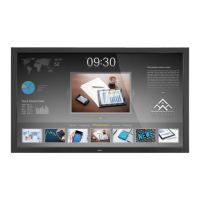Why do I see a snowy picture and poor sound on my NEC MultiSync V652-TM Flat Panel TV?
- JjrodriguezSep 13, 2025
Check the antenna/cable connection. Use a new cable if necessary.

Why do I see a snowy picture and poor sound on my NEC MultiSync V652-TM Flat Panel TV?
Check the antenna/cable connection. Use a new cable if necessary.
| Brand | NEC |
|---|---|
| Model | MultiSync V652-TM |
| Category | Flat Panel TV |
| Language | English |
Details regarding FCC rules for the device's operation and potential interference.
Statement of compliance with Canadian regulations for digital apparatus.
Critical safety warnings about fire, shock hazards, and proper plug use.
Safety cautions regarding electric shock and handling internal components.
Guidelines for safe operation, avoiding liquids, objects, and cord damage.
Advice for optimal performance, eye comfort, and ergonomics.
Instructions for gently wiping the monitor's display surface.
Instructions for cleaning the monitor's exterior cabinet with detergent.
Guidance on physically installing the monitor, including wall/ceiling and location criteria.
Recommended display orientation and checks for mounting apparatus integrity.
Instructions for attaching VESA-compliant mounting accessories to the monitor.
Steps for installing an optional board into the monitor's slot.
Procedures for installing and removing the optional table top stand.
Guidelines for ensuring adequate airflow for heat dissipation around the monitor.
Measures to prevent the monitor from falling when using the table top stand.
Description of buttons and indicators on the monitor's control panel.
Location and function of remote sensor and ambient light detector.
How to activate and deactivate the control key lock feature.
Description of connectors for video and audio input signals.
Description of audio output, speaker, RS-232C, LAN, and option board slots.
Location of internal speakers and the Kensington security lock slot.
Detailed explanation of each button's function on the remote control.
How to select picture modes and adjust aspect ratio using the remote.
Control for Picture-in-Picture and Remote Identification features.
Optimal operating range and precautions for handling the remote control.
Determining installation site and installing remote control batteries.
Procedures for connecting external devices like computers and players.
Instructions for safely connecting the monitor's power cord.
Steps to turn on and operate connected external equipment.
Procedures for fine-tuning audio, screen display, and image quality.
Settings to reduce image persistence and prolong monitor life.
Visual guide illustrating signal connections between devices.
Details on connecting specific equipment to terminal inputs.
Instructions for connecting PCs and display compatibility.
Specifics for connecting HDMI and DisplayPort sources.
Initial setup steps for the touch panel functionality.
How to turn the monitor on and off using buttons or remote.
Understanding the power indicator and adjusting image aspect ratio.
Energy saving features and how to switch video inputs.
How to view monitor information like input source and aspect ratio.
Selecting preset picture modes and ambient light adjustment.
Key guide for using remote control and panel buttons to navigate menus.
How to adjust picture parameters like brightness, contrast, and color.
Detailed descriptions of picture adjustments like backlight, contrast, and color.
Explanation of image alignment and timing adjustments.
Adjusting volume, balance, treble, bass, and surround sound.
Configuring power on/off schedules and date/time settings.
Configuring Picture-in-Picture and text ticker display options.
Selecting OSD language and setting menu display duration.
Configuring information display and multi-monitor ID management.
Settings for RS-232C and LAN external control.
Configuring network parameters like DHCP and IP address.
Settings for power save, screen saver, and auto standby.
Configuring input detection, terminal signal types, and color systems.
Adjusting deinterlacing, over scan, and optional hardware settings.
Configuring touch panel and factory reset procedures.
Steps to program automatic power on/off schedules for the monitor.
Explanation of image persistence and methods to prevent it.
Guidelines for long-term use in public display applications.
How to use the remote control ID mode for individual monitor control.
Assigning monitor IDs and configuring IR control for daisy-chained monitors.
Operating secondary monitors using the primary's remote control signal.
How to connect a PC via RS-232C for monitor control.
Details on RS-232C protocol, baud rate, and cable type.
List of commands and code data for RS-232C monitor control.
Steps to connect the monitor to a network via LAN cable.
Configuring network settings using a web browser interface.
Preparing for browser access and configuring IP/DNS settings.
Configuring email alerts for monitor errors via wired LAN.
Table listing error codes, messages, explanations, and recommended measures.
Reduced footprint, OmniColor, sRGB, and other color controls.
OSD, Plug and Play, IPM system, and FullScan capabilities.
VESA interface, DVI, TILE MATRIX, ZOOM, RS-232C, HDCP, and option slots.
Solutions for missing picture, unresponsive power button, or no LED indicator.
Addressing image persistence, unfocused, or unstable images.
Troubleshooting no sound and unresponsive remote control issues.
Solutions for snowy picture, TV interference, and RS-232C/LAN control issues.
Troubleshooting touch panel response and accuracy problems.
Details on pixel, resolution, frequency, and input signal types.
Specifications for audio output, control interfaces, and power supply.
Operating environment, physical dimensions, and VESA mounting details.
Pin assignment details for the RS-232C input/output port.
Pin configuration for the Remote IN connector.
Guidance on disposing of old NEC products responsibly.
Explanation of energy saving modes and LED indicators.
Information regarding European Union waste electrical and electronic equipment directive.